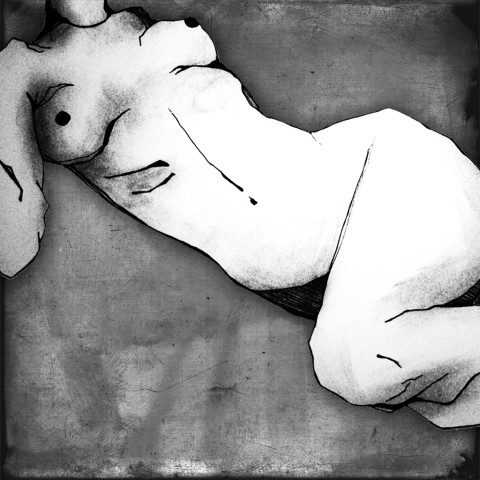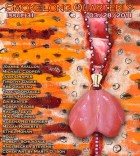The last picture I took of Sigrid was of her chest, the night before she got the soft tissue of her breasts scraped out from inside her through two little half-moon cuts. I took a few steps back from my masking tape cross on the carpet so I could include her face, grinning above her breasts, still heavy and full and familiar. I tried not to think about what would come out of them, something like the hard-packed stuffing of couches under the upholstery, all knotty and dense and still sticking to whatever was left inside.
She was only twenty-three—too young, I thought, to make such a permanent decision about her body, but then again she was only eighteen when she got the Sacred Heart of Jesus tattooed on her left shoulder, and we both agreed that had been an excellent decision. Still, I believed this was different and it was, but in the end it was her body, her breasts, so I’d smiled and said, “That’s great, Sid,” when she’d announced six months earlier over chicken and wine that Janet had recommended her for hormone therapy.
I did what I could to support her. The night before her first injections, I baked her a cake and iced it with the words “Happy T-Day!” and a blue cartoon syringe. I wrapped and gave her as presents any objects I could find in the apartment that began with “T”: toothpicks, Time magazine, tampons, tahini. The next day at the doctor’s office, I tried to imagine her as a sexy, bearded man while I waited for her to return bearing alcohol swabs and a small, seemingly innocuous jar of testosterone. Her man juice, she called it. That night as we lay in bed, her legs threaded through mine, she told me this was natural, like puberty, and I wanted to believe her. I gave her a close-lipped kiss in the dark.
Once a week, I documented her armpits, abdomen, and jaw. She wanted to post her progress online, but for me the pictures would be the explanation I’d need later, when her body as I knew it was gone. The changes were imperceptible at first, but Sigrid insisted the hair was growing. “Feel it,” she said, pressing my palm to her face. I closed my eyes and nodded, feeling nothing.
Only looking back through the pictures later could I see it coming—the thin furry line creeping up from her crotch, the stiff hairs stabbing through the pores of her face. Its spread was as slow and inevitable as the shadow that overtook the living area of our apartment a little earlier each night, as fall slipped into winter.
Four weeks of still relatively hairless pictures later, her voice began to crack like a thirteen year old boy’s. I found it harder and harder to answer her calls during the day, hoping she’d leave me a voicemail, an auditory record like the photographs. Her voice grew more irritable with each message, hardening and deepening into one I hardly recognized. I saved them all. Eventually she switched to sending texts.
Meanwhile, I stopped shaving my legs and underarms, just to see how long and thick the hair would grow. Progress was slow, only a little slower than Sigrid’s, but I took no pictures, and if she noticed she said nothing.
In January, about a week before the surgery, I stopped at Goodwill on my way home from substitute teaching and picked out clothes I would wear if I were a man—not much different, really, than the clothes I was already wearing. I pushed aside the thin blue fitting room curtain and put them on, pulled my hair back under an Indians cap, and tried to believe myself male. I stared at the possibility for five minutes in the mirror, but it didn’t turn me into a man.
Back at the apartment, I found Sigrid in the bathroom, shaving her face.
“It grows back thicker,” she explained.
She kept the bandages on for the first four nights after the surgery, sleeping on her back. The blood cast shadows in the gauze. The fifth night she let me feel around her for the loose end of the dressing. I passed the growing wad of gauze from one hand to the other until she was naked. Where her breasts had been were dark crescent scars.
She took my face in her hands, closed her eyes and kissed me, just once, lightly, on the lips. Then she pulled away, smiling. I don’t know why she was smiling.
“You’re going to have to get used to this,” she said. But already she had begun to exist in my mind as an ex-lover, a stranger I would see again years later and wonder how much of my body she remembered even as I remembered all of hers. I got up and threw the gauze away in the kitchen trash.
When I returned, the light was off. I lay down beside her and stared into the darkness hung below the ceiling, listening to her breathing slow and deepen. I let my hands travel up to my breasts and hold them, trying to imagine my cupped palms empty.
When I was sure Sigrid was asleep, I twisted on my side to view her naked silhouette, following the line of her with my fingers, forearm grazing her stomach as my palm traveled the soft curve sweeping out from her waist. I closed my eyes when I came to the bump of her hip, its suggestion of the skeleton inside her. Her hips, I thought—a boney, voiceless comfort. There was nothing she could do about her hips.



 The core workshop of SmokeLong Fitness is all in writing, so you can take part from anywhere at anytime. We are excited about creating a supportive, consistent and structured environment for flash writers to work on their craft in a community. We are thrilled and proud to say that our workshop participants have won, placed, or been listed in every major flash competition. Community works.
The core workshop of SmokeLong Fitness is all in writing, so you can take part from anywhere at anytime. We are excited about creating a supportive, consistent and structured environment for flash writers to work on their craft in a community. We are thrilled and proud to say that our workshop participants have won, placed, or been listed in every major flash competition. Community works.